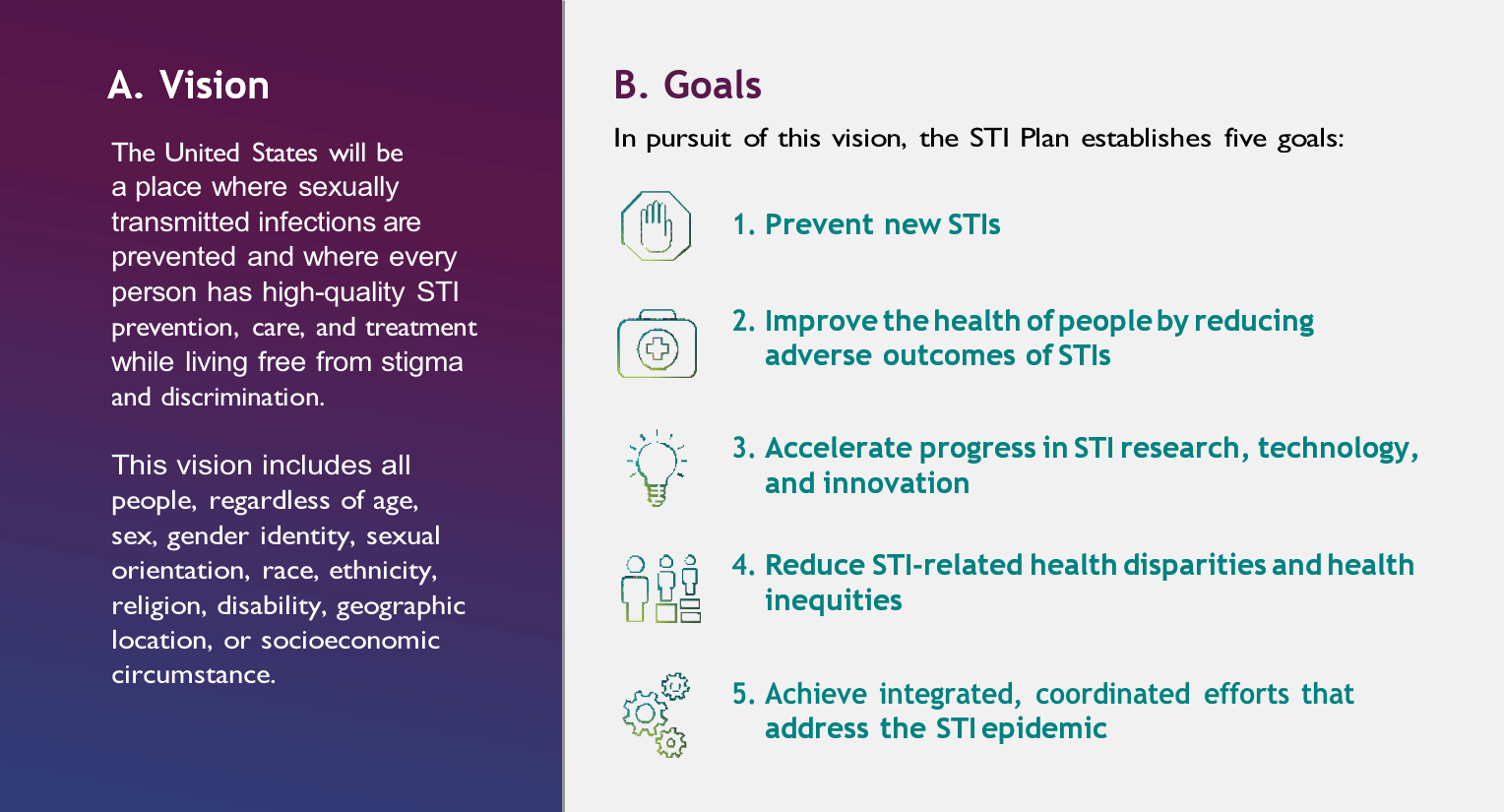The National STI Strategic Plan aims to reverse the recent dramatic increase in STIs in the United States and reduce STI-related health disparities. Ultimately, it aims to improve the health of our country’s population and reduce STI-related health care costs. The STI Plan defines a vision as well as goals, objectives and strategies to respond to this STI epidemic. The goals, objectives and strategies provide a road map for a broad range of stakeholders, including public health, healthcare, government, community organizations, educational institutions, researchers, private industry and academia, to develop, improve and expand the prevention and amelioration of STIs. care programs at the local, state, tribal and national levels over the next five years.
The following is an overview of the vision, objectives and focus areas of the STI Plan.

 Objective 1: Prevent new sexually transmitted infections
Objective 1: Prevent new sexually transmitted infections
Areas of focus include:
- Primary prevention – preventing STIs before they occur
- Raise awareness about STIs and sexual health
- Comprehensive, non-stigmatizing approach to sexual health and sexual well-being education
- Increase completion rates of routinely recommended HPV vaccination
- Provide resources, incentives, training and technical assistance to increase the capacity of health workers and systems.
- Increase the diversity of the workforce that provides STI prevention services
- Integrate STI prevention with HIV, viral hepatitis and substance use prevention services within staff and delivery systems
 Objective 2: Improve people’s health by reducing negative consequences of STIs.
Objective 2: Improve people’s health by reducing negative consequences of STIs.
Areas of focus include:
- Develop high-quality and affordable secondary prevention of STIs, including screening, care and treatment
- Support increased staffing and the role of disease intervention specialists/contact tracers in programs
- Increase STI screening and testing for priority populations, including extragenital STI testing among MSM
- Develop workforce knowledge and experience in ITS through education and training, maintenance of certification, and continuing education programs.
- Optimize, expand the use, and improve the effectiveness of accelerated partner therapy, STI partner services, and linkage to care in programs and settings that provide testing and treatment for STIs.
 Goal 3: Accelerate progress in STI research, technology and innovation.
Goal 3: Accelerate progress in STI research, technology and innovation.
Areas of focus include:
- Increase research and investment to develop STI vaccines and bring them to market
- Support the development and adoption of:
- Multipurpose prevention technologies (MPT) that combine STI prevention and contraception
- Developmental therapeutic agents
- STI diagnostic technologies
- Service point and self-collection
- Rapid determination of antibiotic susceptibility
- Antimicrobial prophylaxis regimens
- Other interventions for identification and treatment of STIs, including new and emerging disease threats
 Goal 4: Reduce health disparities and inequalities related to STIs.
Goal 4: Reduce health disparities and inequalities related to STIs.
Areas of focus include:
- Reduce stigma and discrimination associated with STIs
- Train providers, including primary, specialty, and nontraditional care providers, to provide high-quality sexual health services that are culturally and linguistically appropriate, nondiscriminatory, nonjudgmental, compassionate, and comprehensive.
- Addressing social determinants of health and co-occurring conditions
- Expand policies and approaches that promote STI prevention and care in programs involving housing, education, transportation, the justice system, and other systems that impact the social determinants of health.
 Goal 5: Achieve integrated and coordinated efforts to combat the STI epidemic.
Goal 5: Achieve integrated and coordinated efforts to combat the STI epidemic.
Areas of focus include:
- Establish and intensify the integration of STI-related efforts, policies, and programs with all aspects of the STI syndemic, HIV, viral hepatitis, and substance use disorders.
- This includes stigma, discrimination and social determinants of health
- Improving data related to STIs and social determinants of health
- Includes STI surveillance infrastructure and real-time data sharing
- Align indicators across programs
- Improve mechanisms for assessing progress toward STI plan goals
- Integrated implementation plans – STIs, HIV, viral hepatitis, other communicable infections, substance use disorders
- Communicate progress regularly and correct course if insufficient progress is made
Learn more about the STI Plan Or download the plan to read it -PDF.
